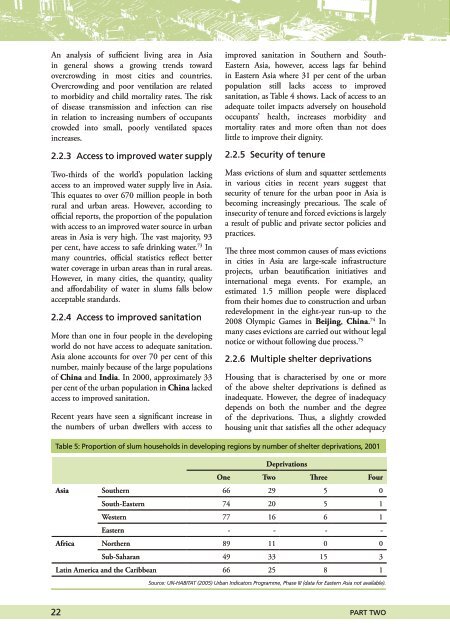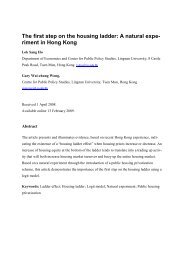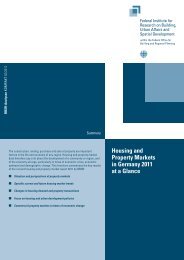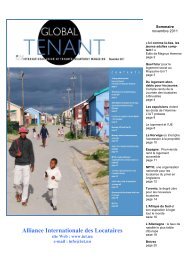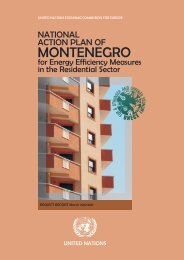affordable land and housing in asia - International Union of Tenants
affordable land and housing in asia - International Union of Tenants
affordable land and housing in asia - International Union of Tenants
- No tags were found...
Create successful ePaper yourself
Turn your PDF publications into a flip-book with our unique Google optimized e-Paper software.
An analysis <strong>of</strong> sufficient liv<strong>in</strong>g area <strong>in</strong> Asia<strong>in</strong> general shows a grow<strong>in</strong>g trends towardovercrowd<strong>in</strong>g <strong>in</strong> most cities <strong>and</strong> countries.Overcrowd<strong>in</strong>g <strong>and</strong> poor ventilation are relatedto morbidity <strong>and</strong> child mortality rates. The risk<strong>of</strong> disease transmission <strong>and</strong> <strong>in</strong>fection can rise<strong>in</strong> relation to <strong>in</strong>creas<strong>in</strong>g numbers <strong>of</strong> occupantscrowded <strong>in</strong>to small, poorly ventilated spaces<strong>in</strong>creases.2.2.3 Access to improved water supplyTwo-thirds <strong>of</strong> the world’s population lack<strong>in</strong>gaccess to an improved water supply live <strong>in</strong> Asia.This equates to over 670 million people <strong>in</strong> bothrural <strong>and</strong> urban areas. However, accord<strong>in</strong>g to<strong>of</strong>ficial reports, the proportion <strong>of</strong> the populationwith access to an improved water source <strong>in</strong> urbanareas <strong>in</strong> Asia is very high. The vast majority, 93per cent, have access to safe dr<strong>in</strong>k<strong>in</strong>g water. 73 Inmany countries, <strong>of</strong>ficial statistics reflect betterwater coverage <strong>in</strong> urban areas than <strong>in</strong> rural areas.However, <strong>in</strong> many cities, the quantity, quality<strong>and</strong> affordability <strong>of</strong> water <strong>in</strong> slums falls belowacceptable st<strong>and</strong>ards.2.2.4 Access to improved sanitationMore than one <strong>in</strong> four people <strong>in</strong> the develop<strong>in</strong>gworld do not have access to adequate sanitation.Asia alone accounts for over 70 per cent <strong>of</strong> thisnumber, ma<strong>in</strong>ly because <strong>of</strong> the large populations<strong>of</strong> Ch<strong>in</strong>a <strong>and</strong> India. In 2000, approximately 33per cent <strong>of</strong> the urban population <strong>in</strong> Ch<strong>in</strong>a lackedaccess to improved sanitation.Recent years have seen a significant <strong>in</strong>crease <strong>in</strong>the numbers <strong>of</strong> urban dwellers with access toimproved sanitation <strong>in</strong> Southern <strong>and</strong> South-Eastern Asia, however, access lags far beh<strong>in</strong>d<strong>in</strong> Eastern Asia where 31 per cent <strong>of</strong> the urbanpopulation still lacks access to improvedsanitation, as Table 4 shows. Lack <strong>of</strong> access to anadequate toilet impacts adversely on householdoccupants’ health, <strong>in</strong>creases morbidity <strong>and</strong>mortality rates <strong>and</strong> more <strong>of</strong>ten than not doeslittle to improve their dignity.2.2.5 Security <strong>of</strong> tenureMass evictions <strong>of</strong> slum <strong>and</strong> squatter settlements<strong>in</strong> various cities <strong>in</strong> recent years suggest thatsecurity <strong>of</strong> tenure for the urban poor <strong>in</strong> Asia isbecom<strong>in</strong>g <strong>in</strong>creas<strong>in</strong>gly precarious. The scale <strong>of</strong><strong>in</strong>security <strong>of</strong> tenure <strong>and</strong> forced evictions is largelya result <strong>of</strong> public <strong>and</strong> private sector policies <strong>and</strong>practices.The three most common causes <strong>of</strong> mass evictions<strong>in</strong> cities <strong>in</strong> Asia are large-scale <strong>in</strong>frastructureprojects, urban beautification <strong>in</strong>itiatives <strong>and</strong><strong>in</strong>ternational mega events. For example, anestimated 1.5 million people were displacedfrom their homes due to construction <strong>and</strong> urbanredevelopment <strong>in</strong> the eight-year run-up to the2008 Olympic Games <strong>in</strong> Beij<strong>in</strong>g, Ch<strong>in</strong>a. 74 Inmany cases evictions are carried out without legalnotice or without follow<strong>in</strong>g due process. 752.2.6 Multiple shelter deprivationsHous<strong>in</strong>g that is characterised by one or more<strong>of</strong> the above shelter deprivations is def<strong>in</strong>ed as<strong>in</strong>adequate. However, the degree <strong>of</strong> <strong>in</strong>adequacydepends on both the number <strong>and</strong> the degree<strong>of</strong> the deprivations. Thus, a slightly crowded<strong>hous<strong>in</strong>g</strong> unit that satisfies all the other adequacyTable 5: Proportion <strong>of</strong> slum households <strong>in</strong> develop<strong>in</strong>g regions by number <strong>of</strong> shelter deprivations, 2001DeprivationsOne Two Three FourAsia Southern 66 29 5 0South-Eastern 74 20 5 1Western 77 16 6 1Eastern - - - -Africa Northern 89 11 0 0Sub-Saharan 49 33 15 3Lat<strong>in</strong> America <strong>and</strong> the Caribbean 66 25 8 1Source: UN-HABITAT (2005) Urban Indicators Programme, Phase III (data for Eastern Asia not available).22PART two


